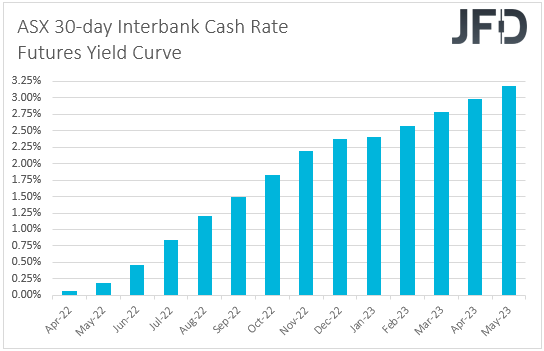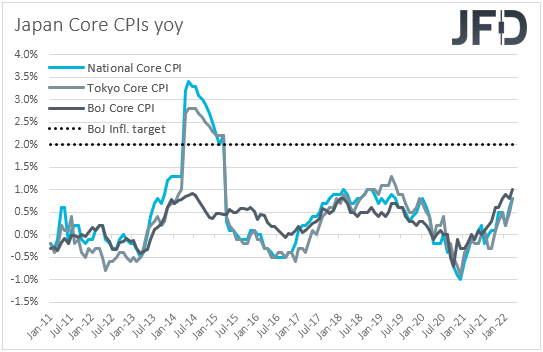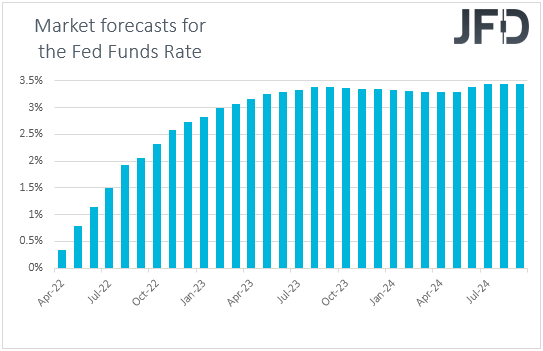There is only one central bank deciding on monetary policy this week, and this is the BoJ. Although no change is expected, we will closely monitor the statement for clues with regards to the yield curve control, as recently, yields have been stubbornly testing the upper end of the Bank’s target range.
With regards to the data, we get Australia’s and Eurozone’s inflation numbers for Q1 and April respectively, while from the US, we get the first estimate of GDP for Q1.
Monday appears to be a relatively light day in terms of economic releases. The only one worth noting is the German Ifo survey for April, but again, it is barely a major market mover. Just for the record, both the current assessment and business expectations indices are forecast to have slid somewhat, which is likely to drive the business climate index a little bit lower.
We had a relatively interesting opening, with the euro gapping up, perhaps due to Emanuel Macron’s victory in the French Election. That said, the joy was short-lived, with the common currency giving back those gains and trading even lower against peers the central banks are expected to proceed with aggressive interest rate hikes, the likes of the US dollar. Remember that last week, we already said that a Macron victory could prove positive for the euro, but we also highlighted that any gains are likely to be temporary and limited.
Now, passing the ball to the stock market, almost 180 companies listed in the S&P 500, are scheduled to report their earnings this week. Among them are the four largest firms by market capitalization: Apple (NASDAQ:AAPL), Microsoft (NASDAQ:MSFT), Amazon (NASDAQ:AMZN), and Alphabet (NASDAQ:GOOGL).
Back to the economic agenda, on Tuesday, during the Asian session, Japan releases its employment report for March, while later in the day, from the US, we get durable goods orders for March, new home sales for the same month, and the Conference Board consumer confidence index for April.
On Wednesday, the most important economic data set due to be released is the Australian CPIs for Q1. The headline rate is forecast to have jumped to +4.6% YoY from +3.5%, while the trimmed mean one is anticipated to have risen to +3.4% from +2.6%. The Weighted CPI is also forecast to have inched north, to +3.3% from +2.7%.
Such numbers are likely to support the Australian dollar, as they will encourage some participants to add to their bets with regard to future rate hikes by the RBA. According to the ASX 30-day interbank cash rate futures yield curve, they expect interest rates to exceed 2.25% by the end of the year.
Remember that the current level of the benchmark cash rate in Australia is 0.10%. Having said all that though, the RBA has yet to confirm whether those expectations are realistic, and thus, any gains due to the CPIs could prove to be short-lived.
We believe that against currencies like the US dollar, the British pound, and the Canadian dollar, we will just see a corrective bounce before the next leg south. Our reasoning is that the Fed, the BoE, and the BoC have already signaled that they will continue with aggressive tightening in the next months.
Later in the day, the only release worth mentioning is the US pending home sales for March, with the forecast pointing to a 1.5% mom slide, after a 4.1% decline in February.
On Thursday, the spotlight is likely to turn to the BoJ monetary policy decision. Usually, meetings of this bank pass unnoticed as it provides little action or important information to excite the markets.
However, things may be different this time around. With the benchmark Japanese government bond yield rising to the upper limit of the central bank’s range, many are eager to hear what policymakers have to say.
The bank has in recent weeks defended its policy under which it pledged to keep 10-Year yields around 0%, within a ±0.25% range, at a time when the Fed is pushing aggressively for sizable rate hikes.
And thus, with yields staying stubbornly near the upper end of the policy range, many market participants believe that the BoJ has to take some sort of action. Some believe that officials should widen the allowable range, while others suggest calling for targeting yields with shorter maturity. There are also a few saying that the bank should give up its yield curve control policy entirely.
Officials are not expected to proceed with any action at this meeting, but the accompanying statement will be monitored closely. Anything pointing to any of the aforementioned changes, or something similar, could prove supportive for the Japanese yen, as it may allow 10-year yields to drift higher.
However, with other major central banks expected to hike at a very aggressive pace and the Bank of Japan maintaining an ultra-loose policy, we doubt that this will signal the beginning of an uptrend in the Japanese currency.
We stick to our guns that the monetary policy divergence between the BoJ and other major central banks is likely to keep the yen downtrend intact. We will consider any decision-related strength as a corrective bounce.
As for the rest of Thursday’s releases, during the Asian session, apart from the BoJ decision, we also have New Zealand’s trade balance and Australia’s retail sales, both for March.
Later in the day, Germany releases its preliminary CPIs for April. The headline rate is forecast to have ticked down to +7.2% YoY from +7.3%, while the HICP one is anticipated to have held steady at +7.6% YoY. This could raise some speculation that Eurozone’s headline inflation rate, due out on Friday, could also stay unchanged, or slide fractionally.
In the US, we have the preliminary GDP for Q1, with expectations pointing to a sizable slowdown to +1.1% QoQ SAAR from 7.1%. Such a slowdown is likely to hurt the US dollar, but we don’t expect it to result in a trend reversal.
After all, the Fed has made it clear that its priority is to battle high inflation, and will do that even if it needs to hike rates by 50 or 75 bps. Remember that last week, Fed Chair Powell said that a 50 bps hike will be on the table at the upcoming gathering and added that it would be appropriate to “be moving a little more quickly”, reinforcing expectations over a triple hike in June.
According to the CME FedWatch tool, participants are fully pricing in a 50 bps increase in May, while they assign a 74.6% chance for a triple hike in June. They also see a 74.0% probability for interest rates to be lifted by another 50bps in July.
So, with all that in mind, we will treat any potential USD slide due to a GDP slowdown as a corrective retreat and an opportunity to enter new long positions. Actually, the US dollar could even strengthen instantly in case the GDP slows by less than anticipated, as this may be interpreted as a positive surprise.
Finally, on Friday, the main releases may be the Eurozone’s preliminary CPIs for April and the 1st estimate of the bloc’s GDP for Q1. With regards to the CPIs, the headline rate is forecast to have held steady at +7.4% YoY, but the HICP excluding energy and food is expected to have ticked up to +3.3% from +3.2%.
In our view, a headline rate staying at extremely high levels and further acceleration in underlying inflation is likely to add credence to last week’s reports that the ECB may decide to hike rates in July. However, even if this is the case, the increasing expectations over an ultra-aggressive stance by the Fed still point to a wide divergence between those two major central banks.
Thus, we still see the path of least resistance for EUR/USD as being to the downside. No forecast is currently available for the GDP.

Later in the day, from the US, we get the personal income and spending rates for March, alongside the core PCE index for the month. Personal income is forecast to have slowed somewhat, to +0.4% mom from +0.5%, while spending is anticipated to have accelerated to +0.6% mom from +0.2%. The core PCE index is expected to have ticked down to +5.3% YoY from +5.4%.
